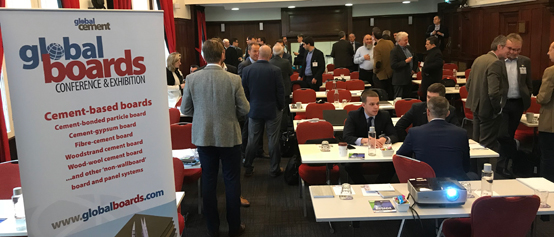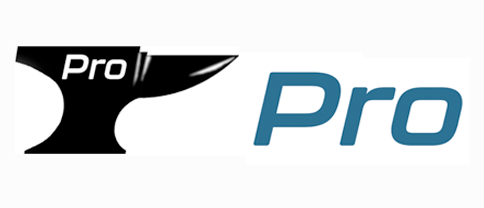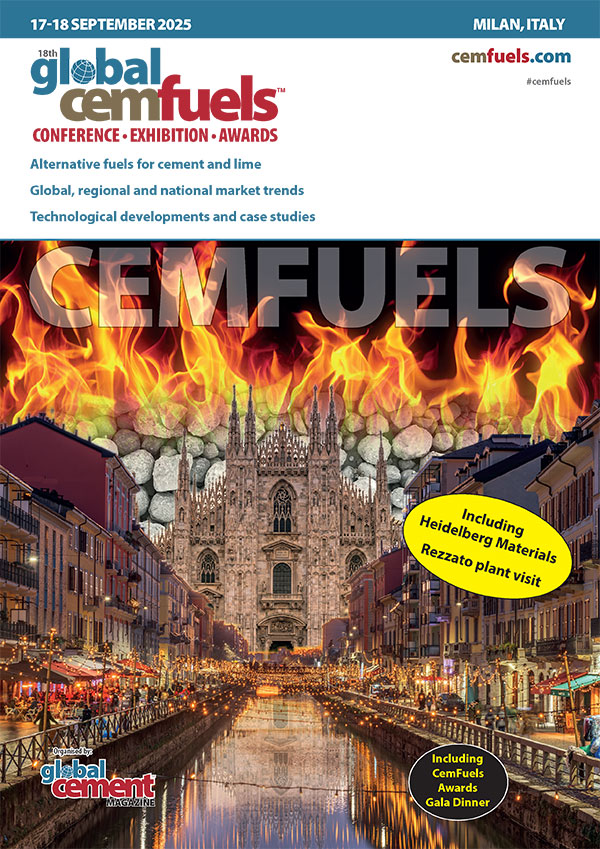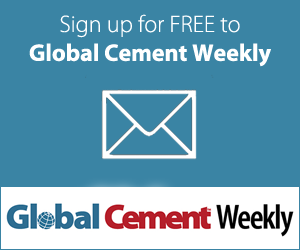
3rd Global CemBoards Conference & Exhibiiton 2018
22 - 23 January 2018, London, UK
The 3rd Global CemBoards conference on cement-based boards successfully took place in London in January 2018, with 60 delegates from 23 countries in attendance.
At the start of the conference, Robert McCaffrey, conference convenor, gave an introduction to cement based boards, outlining the Hatschek process which is commonly used to produce the boards worldwide, and also indicating the wide variety of different board types, including fibre-cement boards, wood-wool cement boards, calcium silicate boards and MgO boards.
Peter Edwards, editor of Global Cement Magazine, next gave an overview of the dominant companies in the sector, based on the recently published Global Boards Directory (GBD), including Etex, Elementia and James Hardie. Excluding China, where there are apparently "over 500 fibre-cement board factories" according to one knowledgeable delegate, the GBD lists around 300 cement-based board companies around the world, with around half of them in Asia, with the largest number of factories in India, the US, Russia, Japan, Brazil and Thailand.
Kalle Kivelä, CEO of Finnish company CrossWrap, spoke about plastic wrapping methods for boards, to provide water and dust protection, as well as providing additional resistance to stress during transport. Kalle suggested that the film used in wrapping is 100% recyclable. Packages of different sizes can be wrapped on the same system. He illustrated his presentation with an example of plywood products from Uruguay being wrapped and shipped to the UK, and others being shipped from Finland to the east coast of the US (with a container transport stage in the middle). An interesting option for efficient container loading, the Actiw Load Plate, was also discussed.
Next up was Steve Marskell of MgO Corp, who spoke about global trends in MgO board technology and markets. His Company's ResCom MgO board products are highly fire-rated and Steve suggested that the weight of board required for sufficient fire-resistance is lower than that of equivalent gypsum-based boards, with resultant savings in all areas.
Frederik Teisner of Qubiqa next spoke on automation in the board industry. Traditionally, automation has been presumed to save money, and to increase production, but also to produce consistency in product quality. Safety and ergonomics for workers are also important considerations for companies. However, Frederik suggested that a new motivation for automation is the lack of skilled, motivated, dedicated, loyal and knowledgable workers. This is for a number of reasons, including that workers with these valuable attributes are now nearing retirement, and also owing to the fact that few in the younger generation aspire to work on the shop floor in a factory: low skilled work is not popular and workers tend to educate themselves to go for higher-skilled jobs. Frederik suggested that automation should be brought to the point where the demand for lower-skilled workers is minimised. Critically, the process of automation starts with data collection: "Data that was previously in the minds of your shop floor workers should be accumulated in your controls and software systems," he concluded.
Steffen Dörrich of Wacker Chemie pointed out that cement-based boards can suffer from a number of problems, including algal growth, efflorescence and blistering of paint. Steffen suggested that silane and siloxane additives can benefit cement-based boards, leading to lower swelling or shrinkage, enhanced free/thaw resistance and by acting as a primer for hydraulic or film-forming decorative coatings, leading to increased longevity of painted fibre cement products. A new product from Wacker, Silres BS 1703, is a transparent liquid which is dosed directly to the mixing tank at a rate of 0.1 - 0.3% and which provides a permanent water repellency to the board, not just on its surface. The iso-octyl-based oligomeric siloxane offers an 'ideal balance' between water solubility and reactivity, due to its tailor-made molecular size. The product has nearly no impact on cement setting times, nor on mechanical strength.
Markus Müller of Sika Services AG rounded-out the first day with a presentation on targeted hardening of cement-bonded building materials. He pointed out that setting and hardening in cement are controlled by different crystallisation processes. Setting accelerators operate over seconds and minutes, but can reduce final strength. Hardening accelerators increase the strength at early ages and act in the first hours and days, but can promote steel corrosion. On the other hand, hardening accelerators can also increase strength if non-cementitious fillers are being used, such as limestone powder, or non-Portland cementitious components, like flyash or ground granulated blast-furnace slag. However, superplasticisers can be used to increase both early and late stage strength, through increasing the electrostatic inter-particle repulsion forces. When used in the wallboard industry, the additives improve the flowability of the slurry at a lower water content and also lead to fewer cavities in the board and fewer product claims.
At the end of the first day of the conference, delegates enjoyed a convivial night out in the Masons Arms, a traditional local pub. Cement-based boards discussions continued long into the night.
On the second day of the conference, Jean-Paul Lecomte of Dow Corning started the programme with a presentation on the protection of fibre-cement boards with silicone and acrylics. Water ingress into the boards (through rain impingement, through moisture passage due to humid conditions or via surface condensation) can dissolve unreacted calcium hydroxide from the board matrix and transfer it to the surface, with crystallisation upon evaporation, leaving a white efflorescence. "Reducing water penetration is not enough to minimise efflorescence, so that it can also be seen in strongly hydrophobised boards as well." Jean-Paul concluded that there is no 'one size that fits all,' and that a mix of several hydrophobising additives might need to be combined to optimise the weather-proofing of fibre-cement boards.
Thomas Williams of Zetland Technologies Limited next spoke about the development of a fibre-cement board incorporating significant quantities of fly ash, primarily due to the large quantities of ash produced by the South African power generation sector. The company wished to develop a technology for a press-based process, to produce a board with adequate compressive strength and other properties comparable with clay bricks, while also offering a product with insulating properties, and at a low cost. A method of granulating a slurry or paste was developed, using a high-shear intimate mixing process, without using heat and using as little water as possible and producing no waste water. The pressed boards produced, using a proprietary 'facilitator' chemical, have a variety of attractive attributes, while the production process can be made as sophisticated or as basic (in terms of technology and labour intensiveness) as market conditions require. The boards produced have a three-dimensional structure, rather than the laminated structure of boards produced in the Hatschek process, avoiding any delamination problems. Platinum slag has also been used as a base material, as well as uncalcined gypsum. An industrial-scale process has been developed, using Eirich high-intensity mixers to produce granules which can then be processed in the same way as other particle-based construction materials such as particleboards. Sandvik TPS equipment has been used to prove the ‘scatterability’ of the granules, as well as showing that a Sandvik double-belt press can be used to continuously press the mixture to produce boards. Alternatively the material can be extruded, although with significantly more difficulty. The boards have received certification for the construction of single-storey dwellings in South Africa.
Alberto Abbo of Bifire, a producer of insulation and boards from Italy, next spoke about the market for and properties of calcium silicate (CaSi) boards. Bifire has produced a CaSi board, 'Supersil,' which was developed with users in mind, such that it is easy to handle, easy to score and snap, and easy to fix in place by one person. The boards have all of the properties expected of CaSi boards and although they are significantly more expensive than gypsum-based wallboards, their properties have found them a ready market, particularly in their home market in Italy.
Peter Graner of Fibrolith Dämmstoffe GmbH gave the penultimate presentation, on wood wool cement board, (WWCB), known in Germany as sauerkraut-platte, or plaque choucroute in France. The Fibrolith factory annually produces in the region of 800,000m2 of boards. The boards are widely used in underground car parks (due to their strong sound attenuation) and in prefabricated buildings. Spruce is the main wood source, and is sustainably certified. The boards have a density from 360-650kg/m3. Peter stated that after a strong dip in demand in Germany starting in the 1970s, from a production of 25Mm2/year to only 2Mm2 in 2000, that demand is coming back, increasing by 50% by 2017 to 3Mm2/year. Total WWCB production in Europe is now around 20Mm2, with the 14 factories in Europe mostly working at full capacity. Peter stated that composite boards, incorporating insulation, are a key growth sector, particularly those using mineral wool and other fire-rated materials. WWCB products are particularly effective at acoustic attenuation. Printing onto the boards is possible, and M2O ('made to order') boards are also significant sectors. Peter raised some eyebrows but impressed with his enthusiasm when he called WWCB, "the sexiest product in the world."
The final presentation at the conference was given by Thomas Robinson of Adaptavate, on the 'breathaboard' bio-composite board for interior applications. Around 60-70% of the weight of the 650kg/m3 board is composed of biomass, typically crop waste. The boards have moisture-buffering properties, offer acoustic attenuation and are able to absorb pollutants from the air and are fully compostable. Thomas stated that the breathaboards have a 'comparable fire-rating to other wallboards.'
At the conference prize-giving for best presentations, as voted by the delegates, Thomas Robinson of Adaptavate was awarded third prize, Thomas Williams of Zetland Technologies was second, and Peter Graner of Fibrolith Dämmstoffe GmbH was awarded first prize for his informative and persuasive talk on the merits of wood-wool cement board.
The conference was very highly praised by delegates for the quality of the contacts and opportunities for networking at the event.
Global CemBoards Conference Delegate comments 2018
- Conference was a good introduction for someone new to the industry and a great opportunity to meet key players.
- Overall well done
- I enjoyed the presentations from alternative board producers
- Great work on an enjoyable event
- Thanks to the organising team
- I enjoyed meeting people from all around the world with different interests
- The organisation was excellent
- We had good discussions
- My favourite things were the speed dating, the good presentations and the evening in the pub!





